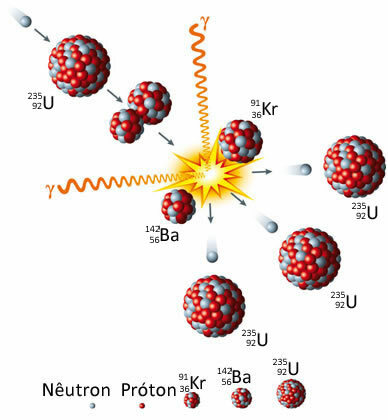In mid-1933, Italian physicist Enrico Fermi observed that when the atomic nucleus of certain elements was bombarded by neutrons in at a moderate speed, this nucleus captured the neutron, emitting gamma radiation (γ), which was subsequently densitized by beta particle emission (-10β) and formed new nuclei of other elements.
Experiments of this nature were carried out by the German physicist Otto Hahn, and the explanation was given by the Austrian physicist Lise Meitner and also by her nephew, the physicist Otoo Robert Frisch. Lise referred to this phenomenon using for the first time the term "nuclear fission". She said that the nuclear fission was when a heavy and unstable atomic nucleus was broken because of the bombardment by moderate neutrons, giving rise to two new medium atomic nuclei and also releasing 2 or 3 neutrons, in addition to an extraordinarily large amount of energy.
This occurs, for example, with the nucleus of uranium-235 (92235U). When it is bombarded by a neutron at moderate speed, it breaks apart, giving rise to several pairs of different nuclei. About 200 different isotopes of 35 chemical elements have already been produced in the fission of uranium-235. See an example below, in which barium isotopes are released (
56142Ba) and krypton (3691Kr), plus 3 neutrons:01n+ 92235U → 56142Ba+ 3691Kr + 3 01no

Note that if the 3 neutrons released in the fission are at moderate speed, they may react again with other uranium-235 nuclei that are present and so continue a Chain reaction which will continue to grow progressively.
However, for this to occur, a minimum mass amount of uranium-235 is required. This smallest fissile mass that sustains the chain reaction is called critical mass. On the other hand, if the mass of uranium-235 is below what is needed for the chain reaction to occur, it is called subcritical mass.
It is this uncontrolled chain reaction that is used in the explosion of atomic bombs, such as those launched by the United States in World War II against the cities of Hiroshima (August 6, 1945) and Nagasaki (three days later) in Japan. The result was the death of 125,000 people in Hiroshima and 90,000 in Nagasaki.

American newspaper report mentioning the atomic bomb dropped by the United States on Hiroshima on August 6, 1945
This gives us an idea of the colossal amount of energy released in nuclear fission. It also shows us that the increase in knowledge of Sciences, such as Chemistry and Physics, can bring enormous harm to human beings if they are not used correctly.
But it can also have benefits. For example, currently the largest application of the nuclear fission reaction is in the use of its released energy to generate electrical energy in nuclear power plants. Basically, the fission reaction is done in a controlled manner, so the energy released is used for heat the water, generating steam that drives a turbine, which operates an electrical generator and produces energy electric.
To understand more about how this is done, read the text Nuclear reactor.

Nuclear plant that uses the energy released in fission reactions to generate electrical energy
By Jennifer Fogaça
Graduated in Chemistry
Source: Brazil School - https://brasilescola.uol.com.br/quimica/reacoes-fissao-nuclear.htm
